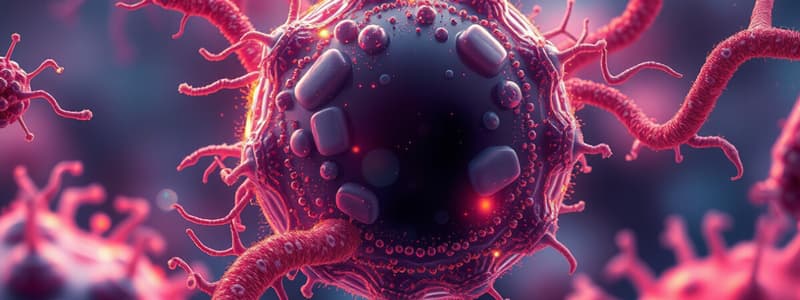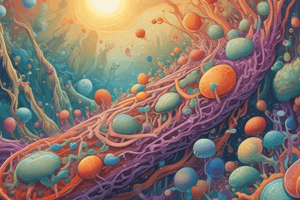Podcast
Questions and Answers
Which of the following is NOT a trophic level in an ecosystem?
Which of the following is NOT a trophic level in an ecosystem?
- Determinants (correct)
- Herbivores
- Producers
- Carnivores
Natural selection leads to populations evolving over time.
Natural selection leads to populations evolving over time.
True (A)
Name one method that provides evidence for evolution.
Name one method that provides evidence for evolution.
Fossil records
The ______ cycle is essential for the function of ecosystems and includes carbon, nitrogen, and phosphorus.
The ______ cycle is essential for the function of ecosystems and includes carbon, nitrogen, and phosphorus.
Match the following terms related to evolution with their appropriate descriptions:
Match the following terms related to evolution with their appropriate descriptions:
Which of the following is a type of eukaryotic cell?
Which of the following is a type of eukaryotic cell?
The Golgi Apparatus is responsible for the power production in a cell.
The Golgi Apparatus is responsible for the power production in a cell.
What structure in the cell contains DNA and controls cell activities?
What structure in the cell contains DNA and controls cell activities?
The law of __________ states that alleles separate during gamete formation.
The law of __________ states that alleles separate during gamete formation.
Match the following microorganisms with their characteristics:
Match the following microorganisms with their characteristics:
Which organelle is involved in protein synthesis?
Which organelle is involved in protein synthesis?
Genetic variation can occur due to mutations.
Genetic variation can occur due to mutations.
List one application of microbiology.
List one application of microbiology.
Flashcards are hidden until you start studying
Study Notes
Cell Biology
- Basic Unit of Life: Cells are the fundamental units of structure and function in living organisms.
- Types of Cells:
- Prokaryotic: Lack a nucleus (e.g., bacteria).
- Eukaryotic: Have a nucleus (e.g., plant and animal cells).
- Organelles:
- Nucleus: Contains DNA, controls cell activities.
- Mitochondria: Powerhouse of the cell, site of ATP production.
- Ribosomes: Protein synthesis.
- Endoplasmic Reticulum: Rough (with ribosomes, protein synthesis) and Smooth (lipid synthesis).
- Golgi Apparatus: Modifies and packages proteins.
- Lysosomes: Digestive enzymes for waste processing.
- Cell Membrane: Semi-permeable barrier, regulates entry and exit of substances.
- Cell Cycle: Phases include interphase (growth) and mitosis (cell division).
Microbiology
- Study of Microorganisms: Includes bacteria, viruses, fungi, and protozoa.
- Bacteria:
- Prokaryotic, diverse metabolic pathways.
- Can be beneficial (gut flora) or pathogenic (causing diseases).
- Viruses: Non-cellular entities that require a host to replicate; consist of DNA or RNA encased in protein.
- Fungi: Eukaryotic organisms that decompose organic matter; can be single-celled (yeasts) or multicellular (molds).
- Protozoa: Single-celled eukaryotes, often motile, with varied feeding mechanisms.
- Applications: Biotechnology, pharmaceuticals, food production, and environmental science.
Genetics
- Basic Unit of Inheritance: Genes, segments of DNA, determine traits.
- DNA Structure: Double helix, composed of nucleotides (A, T, C, G).
- Chromosomes: DNA molecules organized into structures, humans have 46 chromosomes (23 pairs).
- Mendelian Genetics:
- Law of Segregation: Alleles separate during gamete formation.
- Law of Independent Assortment: Genes for different traits segregate independently.
- Genetic Variation: Result of mutations, recombination, and gene flow.
- Modern Genetics:
- Genetic Engineering: Modification of an organism's DNA (e.g., CRISPR).
- Genomics: Study of the entire genome of organisms.
Ecology
- Study of Ecosystems: Interactions between organisms and their environment.
- Levels of Organization:
- Individual: Single organism.
- Population: Group of same species in a specific area.
- Community: Different species interacting.
- Ecosystem: Community plus abiotic factors (e.g., water, climate).
- Biomes: Large ecological areas with distinct climates and organisms (e.g., forests, deserts).
- Energy Flow:
- Trophic Levels: Producers (plants), consumers (herbivores, carnivores), decomposers.
- Food Chains and Food Webs: Energy transfer between organisms.
- Biogeochemical Cycles: Nutrient cycles (carbon, nitrogen, phosphorus) essential for ecosystem function.
Evolution
- Theory of Evolution: Change in the heritable traits of biological populations over successive generations.
- Natural Selection: Mechanism of evolution where organisms better adapted to their environment tend to survive and reproduce.
- Mutation: Random changes in DNA that can lead to new traits.
- Speciation: Formation of new species through processes like geographical isolation and reproductive isolation.
- Evidence for Evolution:
- Fossil records: Show gradual changes over time.
- Comparative anatomy: Homologous structures indicating common ancestry.
- Molecular biology: Similarities in DNA sequences among different species.
- Evolutionary Tree: A diagram showing the relationships among various species based on evolutionary history.
Cell Biology
- Cells are the basic units of life, performing vital functions in all living organisms.
- Prokaryotic cells lack a nucleus, with bacteria being a prime example; eukaryotic cells possess a nucleus, including plant and animal cells.
- The nucleus houses DNA and regulates cellular activities.
- Mitochondria are known as the cell's powerhouse, where ATP is produced for energy.
- Ribosomes are the site of protein synthesis, crucial for cellular function.
- The Endoplasmic Reticulum (ER) is divided into rough (involved in protein synthesis) and smooth (involved in lipid synthesis).
- The Golgi Apparatus modifies and packages proteins for transport.
- Lysosomes contain digestive enzymes for breaking down waste materials.
- The cell membrane is semipermeable, controlling the entry and exit of substances.
- The cell cycle includes interphase, where the cell grows, and mitosis, which is the process of cell division.
Microbiology
- Microbiology focuses on microorganisms, encompassing bacteria, viruses, fungi, and protozoa.
- Bacteria are prokaryotic organisms with a variety of metabolic pathways, which can be either beneficial (e.g., gut flora) or pathogenic (causing diseases).
- Viruses are non-cellular and need a host to replicate; they are composed of either DNA or RNA within a protein coat.
- Fungi are eukaryotic, decomposing organic matter and can exist as single-celled (yeasts) or multicellular forms (molds).
- Protozoa are motile, single-celled eukaryotes with diverse feeding strategies.
- Microbiology has significant applications in biotechnology, pharmaceuticals, food production, and environmental science.
Genetics
- Genes are the fundamental units of inheritance, which determine specific traits in organisms.
- DNA consists of a double helix structure made up of four nucleotides: adenine (A), thymine (T), cytosine (C), and guanine (G).
- Chromosomes are structures that organize DNA; humans have 46 chromosomes arranged in 23 pairs.
- Mendelian genetics includes the Law of Segregation (alleles separate during gamete formation) and the Law of Independent Assortment (different genes assort independently).
- Genetic variation arises from mutations, genetic recombination, and gene flow between populations.
- Modern genetics encompasses genetic engineering techniques (like CRISPR) and genomics, which studies the entirety of an organism's genome.
Ecology
- Ecology examines the interactions among organisms and their environment, emphasizing ecosystems.
- Organization levels in ecology include individuals, populations, communities, and ecosystems, which consist of both biotic and abiotic factors.
- Biomes represent large ecological areas with distinct climates and species, such as forests and deserts.
- Energy flow in ecosystems is organized in trophic levels, consisting of producers (plants), consumers (herbivores, carnivores), and decomposers.
- Food chains and food webs illustrate how energy is transferred among organisms.
- Biogeochemical cycles, including the carbon, nitrogen, and phosphorus cycles, are essential for maintaining ecosystem functionality.
Evolution
- The theory of evolution describes how heritable traits in biological populations change across generations.
- Natural selection is a key mechanism of evolution, favoring organisms that are better adapted to their environment.
- Mutations introduce random changes in DNA that can generate new traits, contributing to evolution.
- Speciation occurs when new species emerge due to geographical or reproductive isolation.
- Evidence for evolution includes fossil records that document gradual changes, comparative anatomy revealing homologous structures indicating common ancestry, and molecular biology showcasing DNA sequence similarities among species.
- An evolutionary tree visually represents the relationships and common ancestry among various species through evolutionary history.
Studying That Suits You
Use AI to generate personalized quizzes and flashcards to suit your learning preferences.




